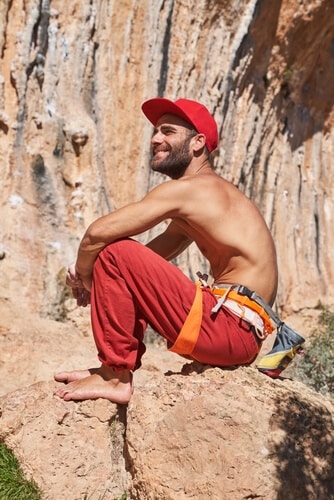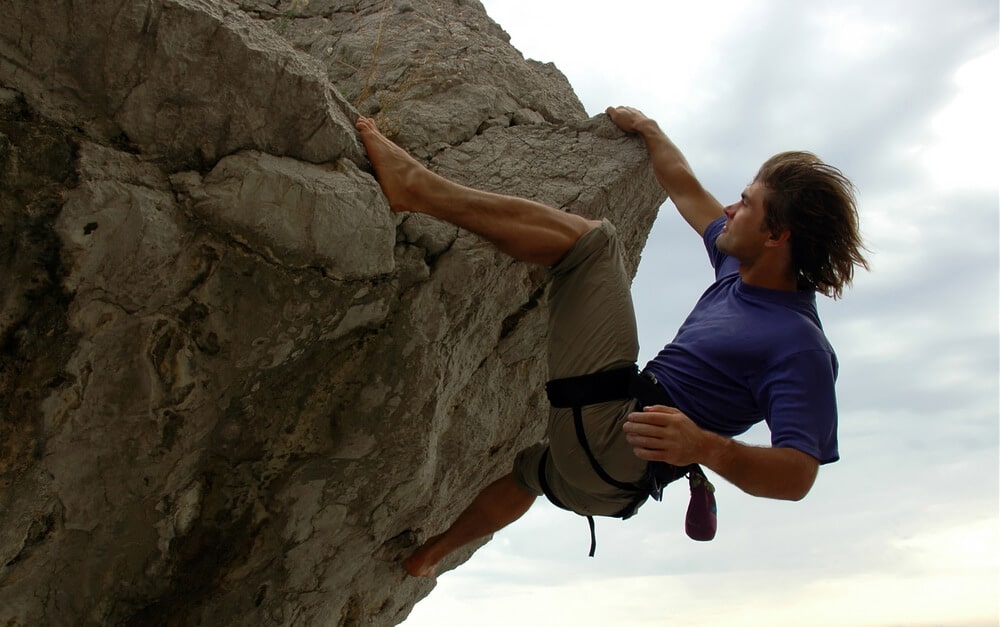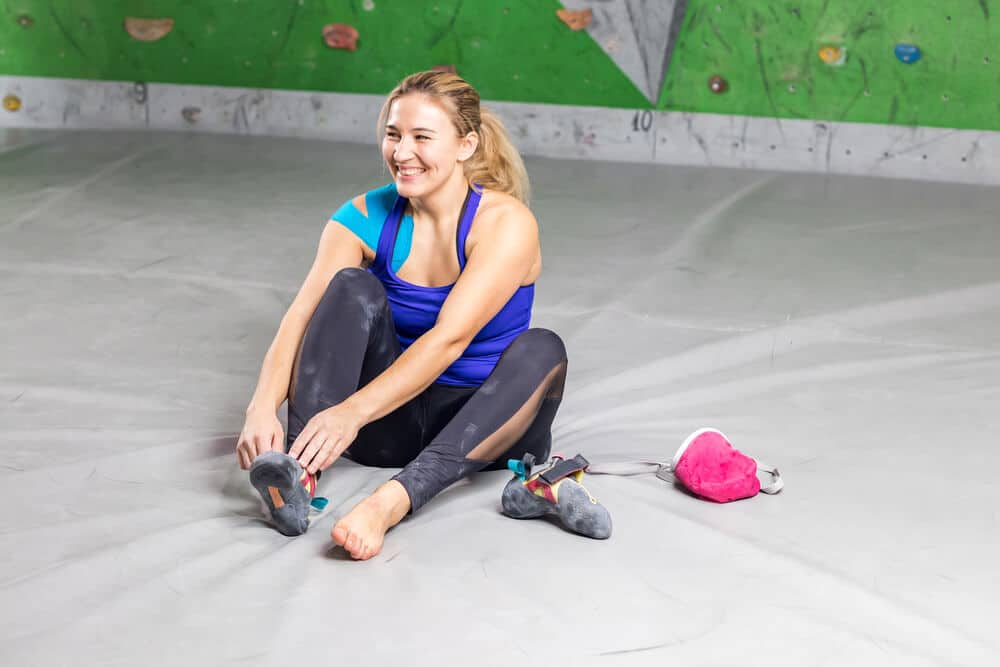As climbers, one of our most important pieces of equipment is our climbing shoes. I’ve certainly spent hours trying on different pairs of shoes over the years, and hundreds of dollars on shoes and resoles.
However, not everyone views wearing shoes as the key to sending. Enter Charles Albert, a French boulderer famous for rock climbing barefoot.
Commonly referred to as Barefoot Charles, this crusher has climbed some of the hardest boulders in the world without shoes.
Is he on to something? Should we all climb barefoot?
Who is Charles Albert?
 © Charles Albert Collection
© Charles Albert CollectionCharles Albert, often called Chard or Barefoot Charles, is probably the most famous barefoot climber of all time. His fame comes from the fact that not only has he made cutting edge ascents of hard boulders, he’s done it all without shoes.
Climbing multiple boulders rated V15 or possibly higher, as Charles has done, would put anyone on the list of top boulderers. But to do it without shoes takes his achievements to a new level.
Charles’ Story
Charles Albert started climbing as a child– his father introduced him to the sport. When Albert was a teenager, he grew out of a pair of climbing shoes, and simply decided not to buy another pair. From that point on, he climbed without shoes on his feet.
When a Reel Rock film was made about Albert, he became famous for living in a remote cave in the boulders of Fontainebleau and foraging for his food. He lived this way for a while, and enjoyed the simplicity and access to climbing that it gave him.
However, Albert now lives in a house with his girlfriend. He reports this has been beneficial for his climbing, especially since he has adequate food now that he is not foraging in the forest.
Notable Ascents
Charles Albert has completed many impressive boulders, all while climbing barefoot. In 2019, he became the first person to send the boulder No Kpote Only, which now gets a grade of V15/V16. Albert originally proposed the grade of V17, but the next ascensionists downgraded the boulder.
Earlier this week, the climbing community heard some exciting news. Albert announced on his Instagram that he had successfully completed a boulder he’s been projecting for years: L’Ombre du Voyageur. L’Ombre du Voyageur is a 30 foot roof crack boulder that had not been climbed previously– Albert’s ascent was the first.
Albert suggested a grade of 9A/V17 for the boulder, making it his second proposed V17. Four years ago, Albert established Voyageur Face à la Mer de Nuage, which is the final third of his new boulder. This climb received a grade of V13, and Albert has been working on the entire line on and off since then.
The climbing community will have to wait until L’Ombre du Voyageur sees more ascents to confirm the V17 grade. Charles thinks that the style in which he climbed it, barefoot and without kneebars, gets a grade of 9A+, so his logic is that even with shoes and kneebars the boulder will still be 9A (V17).
Although Albert primarily climbs boulders, he has dabbled in sport climbing as well. Along with professional climber Seb Bouin, Albert projected Rastaman Vibrations, one of Chris Sharma’s projects which at the time had yet to see a send. This line gets a grade of 5.15b, and footage of their attempts can be found below. Bouin and Albert were unsuccessful; the climb eventually saw its first ascent in 2022, when Alex Megos sent the route.
Charles’ Climbing Technique
Watch any video of Charles climbing, and you might find yourself cringing– it looks incredibly painful! Charles uses his feet to grip holds like pockets or crimps. Although in some cases barefoot climbing can provide a little extra purchase on holds, Charles thinks that overall it makes climbing harder.
His climbing is unique not only because of the lack of climbing shoes. Charles attempts boulders and moves that no one else seems to even think are possible. His fingers are insanely strong, and videos of him bouldering feature him jumping from tiny crimp to tiny crimp, often on an overhang.
Perhaps it is this desire to try to the seemingly impossible that differentiates Charles as a climber. He focuses almost all of his efforts on V15+ boulders, and is most inspired when he’s trying things that he’s truly not sure if he can do.
Barefoot Climbing
Barefoot Charles is certainly the most famous barefoot climber, and he is undoubtedly one of the best climbers in the world. However, he’s not the only one who doesn’t like to wear shoes. Who else has climbed barefoot, and is it something everyone should try?
Barefoot climbers throughout history
Bernd Arnold was perhaps the first person famous for ditching the rock climbing shoes and climbing barefoot. Arnold was a prominent climber in the 1970s and 1980s, and was well known for establishing new climbs– likely over 900 routes over the course of his climbing career!
Trad crusher Skip Guerin climbed lots of hard routes barefoot during his peak in the 1980s. Notable barefoot ascents include the iconic boulder Midnight Lightning (V8) and the Alien Roof (5.12b), both in Yosemite.
Present day barefoot climbers
Another climber known for ditching the shoes is the Vietnamese Vu Nguyen. Vu Nguyen is a climbing guide for Asia Outdoors, and has been climbing barefoot for years. He enjoys the increased sensitivity it gives him on the rock, and it appears to be working for him– he’s climbed up to 5.13 without wearing shoes.
Most climbers still choose to don their rock climbing shoes for hard ascents, but certain climbs demand a bare foot. For example, take Stranger Than Fiction, an iconic 5.14 crack in Indian Creek. This crack has seen only two ascents: it was established by Mason Earle in 2013 and just recently saw its second ascent by Lor Sabourin. Both climbers sent the route with only one shoe, and a taped right foot!
Professional climbers Pete Whittaker and Tom Randall (aka the Wide Boyz) are currently projecting the line, and say in a recent Youtube video that the taped foot beta is helpful: the crack is too narrow at one point to jam a climbing shoe in, so ditching the shoe allows one’s toes to better fit into the crack.
Barefoot rock climbing technique
If you want to try barefoot climbing, there’s some techniques that may make things easier. Instead of edging with the inside edge of your climbing shoe like you normally would, try to edge with your big toe, placing it perpendicular to the wall on small edges.
Another technique you can use is to actually crimp holds with your toes. If you see an edge you would crimp with your fingers, try doing the same thing with your toes. Just as crimping with your fingers can allow you to make minuscule edges useful, crimping with your toes can provide extra purchase!
You can also grab features in the rock with your toes. If there’s a small bump or ridge in the rock, try pinching it between your big toe and your second toe.
Pros of barefoot rock climbing
Deciding not to wear shoes doesn’t sound like much fun to most of us. However, there are some advantages. As noted above, certain techniques like crimping and pinching footholds can give you extra grip on holds. You also have the advantage of increased sensitivity on the wall– without shoes, you are better able to feel exactly where the footholds are.
Another benefit of climbing barefoot is what climbers on Stranger Than Fiction are taking advantage of: the fact that your feet are smaller without shoes. Sometimes, there are narrow cracks or small pockets that you simply can’t jam your shoes into. Feet sans shoes might just be able to slide in!
Climbing barefoot can also be convenient in certain situations, such as deep water soloing. If you’re not wearing shoes, you don’t have any shoes to get wet.
Cons of barefoot rock climbing
Most people find that it’s very difficult to climb without shoes. Some techniques, like heel hooks, are pretty much out of the question, and standing on small edges becomes much more difficult. In general, it’s difficult to use your heels and the outside of your foot as you would in climbing shoes. Thus, you’re very limited in your ability to hook holds.
The introduction of specialized shoes greatly accelerated climbing progress, and for good reason! Whether you’re bouldering or on a rope, going without shoes tends to negatively impact one’s climbing ability.
Another disadvantage of climbing barefoot is that it can hurt! If the rock is sharp, you might cut your feet or scrape them when you fall. The top of your feet have only a thin layer of skin, so if you scrape the tops of your feet on the rock, they tend to bleed.
Without the protection of a shoe, you also have the potential of doing more serious damage to your feet. The two main arteries in your foot, posterior and anterior tibial artery, are at a higher risk of injury because of exposure to the rock and the damage that can happen if you take a fall while bouldering. Your nails are also at risk: there’s a chance of developing a fungal nail infection or even ripping off an entire toenail.
Can you climb barefoot indoors?
If you want to climb barefoot, you’ll probably have to do it outdoors. Most climbing gyms simply don’t allow barefoot climbing due to hygienic risks. If climbers are constantly putting their bare feet on the same holds as their hands, there’s risk of spreading things like a fungal infection or athlete’s foot. Climbing indoors is not the place to try out this technique!
Barefoot climbing shoes
If you want to know what it’s like to climb barefoot but aren’t quite ready to ditch the shoes, there are some climbing shoes designed to mimic this style. This is also a good option if you are climbing indoors and don’t have the option to go totally without shoes.
Using a soft pair of climbing shoes allows you to have some of the benefits of barefoot climbing, like increased sensitivity and ability to feel the footholds. If the shoes are soft enough, you may even be able to put your toes to use and grab some holds!
If you want to try a shoe like this, a model to check out is the Scarpa Veloce. This shoe is extremely soft and sensitive. It’s very lightweight and breathable too, so it almost feels like you really are barefoot!
Conclusion
If you’re inspired by the impressive ascents of Barefoot Charles and want to climb without shoes, you should now have a better idea of the techniques, as well as some of the pros and cons. Most climbers don’t find ditching the shoes to be much fun, but there are some outliers for whom it seems to work strangely well.
If you decide to climb barefoot, take extra care of your feet and make sure not to climb in the gym without shoes. And if you have no interest in this painful experience, enjoy reading about the crazy folks who do!
Sources
Featured image: @neilhart34














